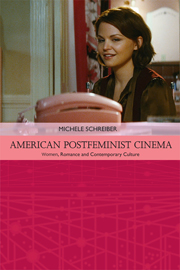Book contents
- Frontmatter
- Contents
- Acknowledgments
- List of Illustrations
- Introduction: Women, Postfeminism and Romance
- 1 ‘Both Glad and Sorry’: Romance Cycles and Women's Politics
- 2 Pragmatism vs. Sentimentality: Amelioration in the Postfeminist Cycle
- 3 Past vs. Present: Temporality in the Postfeminist Cycle
- 4 Sexy vs. Funny: Sexuality in the Postfeminist Cycle
- 5 Independence vs. Dependence: Economics in the Postfeminist Cycle
- Conclusion: Beginnings vs. Endings: the Future of the Postfeminist Cycle
- Selected Bibliography
- Index
Conclusion: Beginnings vs. Endings: the Future of the Postfeminist Cycle
Published online by Cambridge University Press: 05 September 2014
- Frontmatter
- Contents
- Acknowledgments
- List of Illustrations
- Introduction: Women, Postfeminism and Romance
- 1 ‘Both Glad and Sorry’: Romance Cycles and Women's Politics
- 2 Pragmatism vs. Sentimentality: Amelioration in the Postfeminist Cycle
- 3 Past vs. Present: Temporality in the Postfeminist Cycle
- 4 Sexy vs. Funny: Sexuality in the Postfeminist Cycle
- 5 Independence vs. Dependence: Economics in the Postfeminist Cycle
- Conclusion: Beginnings vs. Endings: the Future of the Postfeminist Cycle
- Selected Bibliography
- Index
Summary
Like any conceptual framework, the one I have outlined in American Postfeminist Cinema is not intended to be exhaustive but rather to serve as a jumping off point for future conversations about both romance and postfeminist media. As my breakdown of the structural and discursive elements of the cycle in the Introduction reveals, there are countless texts that have been produced since the beginning of the 1980s that could fall into the binaries that I outline in my case studies, just as there are certainly many other binaries that dominate postfeminist culture that could generate additional case studies. However, I have also argued that we can learn a great deal more about the postfeminist romance cycle, both past and present, if we continue to eliminate the typically iron-clad binary between comedy and drama and the boundaries between film and other media, and even social discourse. For in the preceding chapters, we have examined how the postfeminist period has seen its most potent and contentious concerns addressed and negotiated through romance's narrative structure in diverse forms, of which film remains central.
While I hope American Postfeminist Cinema will inspire new research projects, here I briefly consider what our case studies have shown us about endings, which seems a particularly appropriate task for the end of a book about romance. At many points throughout this study, we have discussed how the momentum of romance, in both life and entertainment, moves toward a resolution and conclusion. And indeed, as discussed in the Introduction, the ending of a narrative has a central place in debates over the differences between comedy and drama.
- Type
- Chapter
- Information
- American Postfeminist CinemaWomen, Romance and Contemporary Culture, pp. 170 - 177Publisher: Edinburgh University PressPrint publication year: 2014



